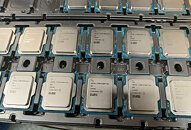
Steam Deck "Engineering Sample No. 34" Sold on Ebay for $2000 - Reportedly an AMD "Picasso" APU-powered Prototype
Not too long ago, Storm City Retro's Ebay store listed an unusual Steam Deck model—the original asking price was $2999.99, although potential buyers were allowed to bid with "best offers." The sales page was titled: "Early Valve Engineering 34 Prototype Steam Deck 256 GB, Tested, Please Read!" Gary_the_mememachine—a member of the Steam Deck subreddit—reported an eventual successful transaction, on April 8. The seller—a "primarily online" Kirkland, Washington-based retro video specialist—managed to attract a buyer; who apparently bagged "Engineering Sample No. 34" for a cool two thousand bucks. Given the presence of a sticker that states "not for resale," Valve is likely not enthused by the appearance of pre-commercial phase hardware via second hand channels. The company's Bellevue HQ is located not too far away from Storm City Retro's placement; both being in the Greater Seattle (Pacific NW) area. Kotaku reached out to its contacts at Valve, but a spokesperson has not provided a comment regarding the alleged leak of an AMD "Picasso" APU-powered engineering sample.
Handheld gaming device experts have analyzed saved screenshots and photos; prototype number 34 seems to of February 2020 vintage. It was compared to various "officially revealed" prototype units—as seen in an informative infographic. An exact match was not found in this compilation, but it is obvious that No. 34 differs greatly—externally and internally—when lined up against final retail models. In 2022, Pierre-Loup Griffais—one of the architects of SteamOS—provided some insight about a similar looking proto device: "the best part is that they (mostly) all still boot, serving as an exciting reminder of how far things have come since. This one has a Picasso APU, at about half of the GPU power of the final Deck. The flatter ergo was an interesting experiment and taught us a ton about comfort." The Steam Deck LCD model launched back in early 2022, with a custom 7 nm AMD Ryzen "Aerith" APU onboard—utilizing Zen 2 + processor cores and RDNA 2 graphics architecture. An OLED refresh arrived over a year later with a die shrink; now 6 nm. Team Red had kindly prepared a more efficient Ryzen "Sephiroth" mobile processor design.
Handheld gaming device experts have analyzed saved screenshots and photos; prototype number 34 seems to of February 2020 vintage. It was compared to various "officially revealed" prototype units—as seen in an informative infographic. An exact match was not found in this compilation, but it is obvious that No. 34 differs greatly—externally and internally—when lined up against final retail models. In 2022, Pierre-Loup Griffais—one of the architects of SteamOS—provided some insight about a similar looking proto device: "the best part is that they (mostly) all still boot, serving as an exciting reminder of how far things have come since. This one has a Picasso APU, at about half of the GPU power of the final Deck. The flatter ergo was an interesting experiment and taught us a ton about comfort." The Steam Deck LCD model launched back in early 2022, with a custom 7 nm AMD Ryzen "Aerith" APU onboard—utilizing Zen 2 + processor cores and RDNA 2 graphics architecture. An OLED refresh arrived over a year later with a die shrink; now 6 nm. Team Red had kindly prepared a more efficient Ryzen "Sephiroth" mobile processor design.



















































































